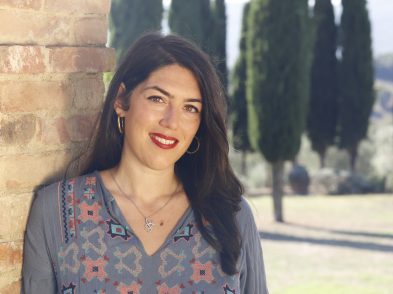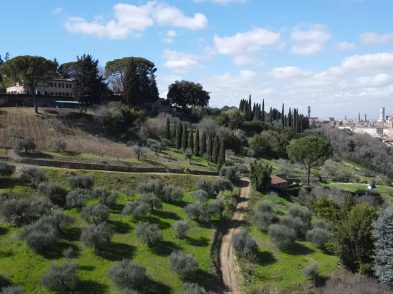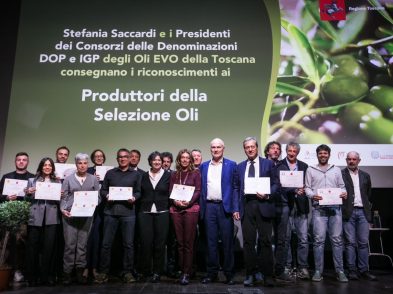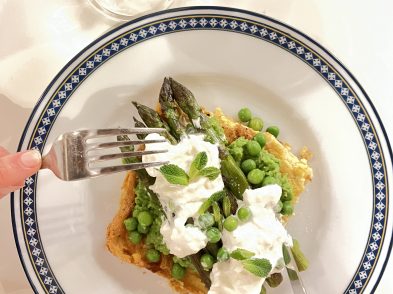Walking into the sumptuous surroundings of Palazzo della Gherardesca is always a soothing and pleasurable experience, but it is all the more so when one is about to meet the Four Seasons Florence’s Michelin-starred chef, Vito Mollica. Modest in his success and amiable with all, Basilicata-born Mollica talks about his origins and influences, his culinary career—and even generously shared a recipe or two.
Helen Farrell: Giorgio Pinchiorri and Annie Feolde affectionately call you ‘Don Vito’. They say that your ‘cuisine demonstrates knowledge of technique’ and that your origins are ‘joyous and generous when it comes to flavour.’ Can you tell us a bit about your origins and how your cuisine might reflect them?
Vito Mollica: Your origins, in whatever field you work, never leave you. I believe that you should always convey your origins in what you do. For a chef, you can convey them through the ingredients you use. For me, with my origins from Basilicata, I am lucky to come from a land that offers an array of ingredients. I’m able to put these to use in haute cuisine, too.
HF: The signature dish at the Four Seasons Florence’s restaurant Il Palagio is Cavatelli pasta, Cacio e Pepe with red prawns and marinated baby squid. Why is this dish in particular viewed as the restaurant’s signature dish?
VM: This dish is so important because the Guida Ristoranti Espresso [the influential Italian restaurant guide] gave us a prize for it. Otherwise it wouldn’t have become so important and nobody would ask us, ‘Why this dish?’ It’s a team effort. Cacio e pepe, just like garlic and oil, tomato and basil, are dishes that are not invented by individual chefs; they are part of the genetic make-up of every single individual. That’s probably why it’s proven so successful. Where we’ve taken a gamble with it is by combining cheese and pepper with fish. Why? To lighten the pepperiness. Prawns and squid go wonderfully with it.

HF: Is there a dish that you serve here at Il Palagio that you feel is more representative of Vito Mollica?
VM: It’s not so much one particular dish or recipe, but more often than not it’s the ingredients that represent me. I come from a village called Avigliano, which is famous throughout Basilicata, and even in Puglia, for its baccalà [dried salt cod]. So I always include baccalà on the menu; in some form, it is almost always there.
HF: Prior to coming to work at Four Seasons Florence, you worked in Prague, in the Netherlands, in the United Kingdom, and elsewhere. Have your experiences overseas shaped you as a person and as a chef?
VM: Without a doubt. As a person, definitely. As a chef, spending time abroad has contributed to the way I think about cooking. Before coming here, I worked at Four Seasons Prague. In fact, I have been very fortunate to have opened two restaurants in two beautiful cities. Here, in Florence, it was easier as Tuscany offers truly incredible ingredients, from fish to vegetables and fruit and meat. Tuscany really is a princely region worldwide when it comes to gastronomy. What I developed abroad was my ability to manage staff. It’s based on being able to adjust. When you’re overseas, you have to adjust to your surroundings.
HF: For a chef, does working for an international luxury hotel place limitations on your creativity? Or does it help your creativity in some way?
VM: Both. A chef not working in a hotel doesn’t have to worry about breakfast. He has the morning available to go to the market, to do other things. He doesn’t encounter any diners until 1pm. Our guests are here 24 hours a day. The advantage is that we have a large kitchen brigade; we have outstanding ingredients available to us; and being part of the hotel, we can be a bit freer in terms of expenditure.

HF: You were awarded Chef of the Year by Italian newspaper Il Sole 24 Ore and Il Palagio won its first Michelin star in 2011. Can you tell us a little about what it’s like for a chef to receive such accolades?
VM: I was at Four Seasons Prague for seven years. The restaurant there won a star four or five months after I left, so I felt like it was a bit mine, although it wasn’t of course. It belonged to the chef there at the time, and rightly so as he was in charge then. Here, we worked hard for the guests, but with the idea of winning the Michelin star. I’d be lying if I said otherwise. We were happy to win the star so soon; for a hotel to do so within three years is a real achievement. It means that we’ve managed to create a restaurant within a hotel, not your average hotel restaurant. Winning the star was a beautiful experience. I wasn’t in Italy at the time—I was away on a business trip with the hotel’s general manager in Moscow—so, when we received the news, at first we thought it was a joke.
HF: Has anything changed for you and for the restaurant with the arrival of the star?
VM: Yes, it has brought more continuity and more business. In the past, we would go from being full to empty, both in the summer and in the winter. Now, we’re either full or half full, but the restaurant is never totally empty.
HF: I imagine that the Michelin star means that you are ‘obliged’ to do more public relations, like this interview, instead of actually cooking and creating.
VM: Yes, that’s true. But doing PR means more attention for the restaurant and more jobs for people. Lots of people say to me, ‘Wow, you’re famous!’ I always say, ‘Well, I don’t know about that!’ It’s a pleasure, but at the end of the day, it’s just a job.
HF: At the Four Seasons, you offer afternoon tea and Sunday brunch, and special events such as Thanksgiving dinner. Is there anything else in the pipeline for an international clientele?
VM: We always try to follow what’s going on with our guests. The Russian market has grown considerably, so we strive to observe the Russian New Year, which comes a week after Russian Christmas, and Russian Easter. We try to offer these visitors something special for these occasions. This year, we also held a celebration for the Jewish Passover for 80–90 guests.
HF: Do you have a favourite restaurant that you go to when you’re not working?
VM: When I’m not working, I spend as much time as possible with my children. We go to child-friendly places, pizzerie, restaurants that we can go to with them. I try to be a dad rather than a chef.
HF: Would you be willing to share one of your very own recipes with the readers of The Florentine?
VM: Of course, caspita! Which one? Pasta? Meat? Something with game perhaps!

Vito Mollica’s recipe
Homemade pici pasta with pheasant ragout, autumn mushrooms and pecorino cheese
(serves 10)
INGREDIENTS
For the pheasant ragout:
2 pheasants, boned and diced, set the bones aside
400g onions, coarsely chopped
400g carrots, coarsely chopped
320g celery, coarsely chopped
1 glass white port
400g tomato sauce
200g mixed autumn mushrooms
1 shallot
50g freshly grated pecorino
Salt and pepper
For the pici:
750g flour, preferably of the ‘00’ variety
250g durum wheat semolina
20ml extra-virgin olive oil
450ml water
1 whole egg, lightly beaten
PREPARATION
Make a well with the flour and semolina and add the whole egg, salt and oil. Start to mix together well, gradually adding the water. Shape into a ball and set aside to rest for about 30 minutes. Once rested, shape the pici into large, fat spaghetti measuring 5mm in diameter and 30cm long.
Brown the pheasant bones in a drizzle of oil. Add 200g of the carrots, 200g of the onions and 160g of the celery and brown. Add plenty of cold water to cover and simmer for about 3 hours, often removing the froth.
Brown the remaining carrots, onions and celery in a little oil. Once the vegetables have browned, add the pheasant meat. Drizzle with the white port. Add the tomato sauce. Cook for 3 hours, adding the pheasant bone stock from time to time. Clean and chop the mushrooms. Sauté in a pan with oil and the chopped shallot. Cook the pici in a large pot of salted water for about 5 minutes. Serve with the pheasant ragout, the sautéed mushrooms and a sprinkling of grated pecorino.







